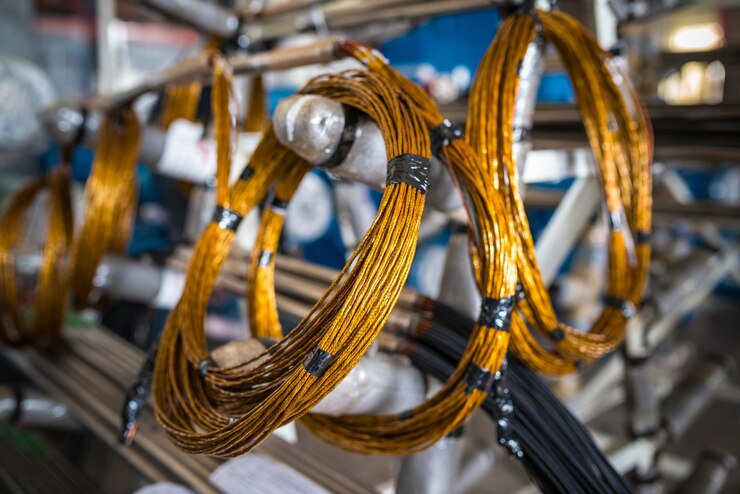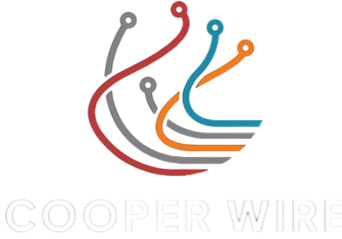Blog
Copper Wire: A Comprehensive Guide – Cooper Wire

Copper wire is an unsung hero in the world of electrical systems. It’s flexible, durable, and conducts electricity like no other material. Whether you’re wiring a new home or repairing old appliances, understanding copper wire can make all the difference. This guide will take you through everything you need to know about copper wire—from its remarkable properties and various types to innovative applications that go beyond traditional use.
As we delve deeper into this essential component of modern life, you’ll discover why so many industries rely on it for efficient performance. So grab your toolkit and let’s explore the fascinating world of copper wire together!
The Properties and Uses of Copper Wire
Copper wire boasts exceptional electrical conductivity, making it a top choice for wiring applications. This metal allows electricity to flow with minimal resistance, ensuring efficient energy transfer.
Its malleability offers flexibility in design and installation. You can easily bend or shape copper wire without breaking it, which is ideal for intricate projects.
Copper’s resistance to corrosion enhances its longevity. It maintains performance even in challenging environments, meaning less frequent replacements are needed.
Beyond electrical wiring, finds use in various industries. It’s commonly used in telecommunications, automotive manufacturing, and even art installations.
Its antibacterial properties make it suitable for medical applications as well, helping reduce the risk of infection in certain devices.
With these traits combined, remains a versatile element across diverse sectors.
Different Types of Copper Wire
Copper wire comes in various types, each designed for specific applications. The most common include solid copper wire and stranded copper wire.
Solid consists of a single conductor. It’s ideal for permanent installations where flexibility isn’t required. This type is often used in residential electrical systems.
Stranded copper wire, on the other hand, comprises multiple thin strands twisted together. Its flexibility makes it perfect for applications requiring movement or bending, such as automotive wiring and portable devices.
There are also specialty types like enameled used in motors and transformers due to its insulation properties.
When dealing with high-frequency signals, Litz wire is popular because it reduces skin effect losses by using many fine wires woven together. Each type serves unique needs across industries while maintaining the essential qualities of conductivity and durability that make copper so valuable.
Advantages and Disadvantages of Using Copper Wire
Copper wire offers excellent electrical conductivity, making it a preferred choice in various applications. Its ability to efficiently carry current reduces energy loss, which is crucial for both residential and industrial settings.
Another advantage lies in its malleability. Copper can be easily shaped and twisted without breaking, allowing for versatile installations across different environments.
However, it also has some drawbacks. It is more susceptible to corrosion compared to other metals like aluminum. This can affect performance over time, especially in humid conditions.
Additionally, the cost of copper fluctuates significantly due to market demand. This price volatility may impact budgeting for projects that require extensive wiring.
While its advantages often outweigh the disadvantages, understanding both sides helps users make informed decisions on their wiring needs.
Proper Maintenance and Care for Copper Wire
Proper maintenance of copper wire is crucial for ensuring longevity and efficiency. Regular inspections can help identify any wear or damage early on.
Keep the wiring clean by removing dust and debris, which can cause corrosion over time. A simple wipe with a dry cloth often suffices. For more stubborn grime, use a mild cleaning solution designed for metal surfaces.
Pay attention to connections as well. Loose or corroded terminals can lead to poor conductivity and potential hazards. Tightening them periodically will enhance performance.
Avoid exposure to moisture whenever possible since it accelerates oxidation, leading to deterioration. If wires are exposed outdoors, consider using protective coatings that shield against environmental factors.
Handle with care during installation or repairs. Rough handling may compromise the integrity of the wire itself, diminishing its effectiveness in conducting electricity safely.
Alternative Materials for Wiring
When considering alternatives to copper wire, aluminum wiring stands out. It’s lighter and more affordable than copper. However, it requires larger gauge sizes due to higher resistance.
Fiber optic cables are another innovative option. They transmit data using light signals rather than electricity, making them ideal for high-speed internet connections. They also resist electromagnetic interference.
For specialized applications, materials like silver or gold are used in electronics where conductivity is critical. While they offer superior performance, their cost can be prohibitive for general wiring needs.
Thermoplastic elastomers provide flexibility and durability in certain environments. This material resists abrasion and extreme temperatures but may not match the conductivity levels of metals.
Biodegradable options are emerging as well, driven by sustainability concerns. Such materials could revolutionize how we think about wiring in eco-conscious projects without compromising on efficiency or safety.
History and Uses of Copper Wire
Copper wire has a rich history that dates back thousands of years. Ancient civilizations utilized copper for various purposes, from tools to decorative items. Its electrical conductivity was discovered much later, leading to widespread adoption in the 19th century.
With the advent of electricity, became essential for power transmission and telecommunications. This sturdy metal efficiently carries electric current and resists corrosion, making it ideal for wiring homes and industries.
Today, copper wire is found in nearly every aspect of modern life—whether it’s powering devices or connecting networks. Innovations continue as technology advances; smart grids and renewable energy solutions rely heavily on high-quality copper wiring.
From its ancient roots to contemporary applications, copper’s versatility remains unmatched in both commercial and residential settings. Whether used in motors or electronic circuits, its significance continues to grow as our reliance on electricity increases.
Types of Copper Wire
Copper wire comes in various forms, each tailored for specific applications. One of the most common types is solid copper wire, featuring a single strand of copper that offers excellent conductivity and strength. It’s often used in electrical installations where durability is essential.
Stranded copper wire, on the other hand, consists of multiple thinner strands twisted together. This design makes it more flexible and easier to work with, ideal for applications requiring movement or bending.
Another variant is enameled copper wire, which has a thin layer of insulation applied directly to the surface. This type finds its niche in winding electric motors and transformers due to its compact nature.
There’s tinned coated with tin to enhance corrosion resistance. It’s frequently used in marine environments or outdoor settings where moisture exposure can be an issue. Each type serves distinct needs while harnessing the properties that make copper such a valuable material.
How is Copper Wire Made?
Copper wire production begins with mining copper ore, which is then crushed and ground. This process releases the valuable metal from its surrounding rock.
The next step involves smelting, where the ore is heated to high temperatures in a furnace. Here, impurities are removed, resulting in pure copper.
After smelting, the molten copper is poured into molds to create large ingots or cakes. These solidify and cool down before undergoing further processing.
Once cooled, these ingots are reheated and passed through rolling mills. The machines flatten them into thin sheets or strips that can be easily shaped into wire.
The wire undergoes drawing processes that continuously pull it through smaller dies until achieving the desired diameter. Coiling follows this stage for easy handling during shipping and installation of various electrical applications.
Advantages and Disadvantages of Copper Wire
Copper wire boasts several advantages that make it a popular choice for electrical applications. Its excellent conductivity ensures efficient transmission of electricity, reducing energy loss. Copper is also highly malleable, allowing it to be easily shaped and twisted into various forms.
However, there are some downsides too. One significant disadvantage is its cost; copper tends to be more expensive than other materials like aluminum.
Additionally, copper can corrode over time when exposed to moisture or chemicals, which may lead to reduced performance and potential safety risks.
Weight is another factor; can be heavier compared to alternatives, making installation in certain environments more challenging.
Despite these drawbacks, many still prefer copper due to its reliability and long-standing history in the industry. Understanding both sides will help you make informed choices for your wiring needs.
Safety Precautions when Working with Copper Wire
When working with copper wire, safety should always be a top priority. First and foremost, wear protective gear such as gloves and goggles. This helps shield your hands and eyes from sharp edges or accidental sparks.
Ensure that the workspace is clean and well-lit. Clutter can lead to accidents, so keep tools organized. Also, make sure you are using insulated tools to prevent electrical shocks.
Always disconnect power sources before starting any work on electrical wiring. Double-check that circuits are turned off to avoid unexpected surges.
If you’re dealing with thicker guage wires, use appropriate cutting tools designed for heavy-duty tasks. This reduces strain on your hands and ensures cleaner cuts.
Educate yourself about the specific properties before beginning any project. Knowing how it reacts under certain conditions can prevent mishaps during installation or repairs.
Maintenance and Upkeep of Copper Wire
Maintaining copper wire is essential for its longevity and performance. Regular inspections can catch any signs of wear or damage early on, preventing costly repairs later. Look for fraying, corrosion, or discoloration.
Keep the wiring clean by gently wiping it with a dry cloth to remove dust and debris. Avoid using harsh chemicals that could degrade the wire’s surface.
Ensure proper insulation around the to prevent exposure to moisture and other elements. This will help maintain conductivity and reduce risks associated with short circuits.
When storing excess wires, coil them neatly without kinks or bends. This practice preserves their integrity and makes them easier to use in future projects.
Remember to check connections periodically as loose fittings can lead to overheating or power loss. Taking these simple steps ensures your copper wiring remains reliable over time.
Innovative Uses for Copper Wire
Copper wire isn’t just for electrical applications anymore. Its versatility opens the door to creative and innovative uses across various fields.
In art, copper wire transforms into stunning sculptures or intricate jewelry pieces. Artists appreciate its malleability and striking color, allowing them to craft unique designs that catch the eye.
Gardeners also love using in landscaping. It can serve as plant supports or be woven into trellises, adding both functionality and aesthetic appeal to outdoor spaces.
Moreover, DIY enthusiasts find endless potential with in home décor projects. From wall hangings to custom light fixtures, it brings a modern touch while remaining practical.
Even in technology, researchers are exploring new ways to integrate copper wiring into advanced electronics for better conductivity and lower energy loss. The possibilities seem limitless when it comes to innovative applications of this remarkable material.
Conclusion
Copper wire plays a vital role in modern applications. From household wiring to industrial machinery, its versatility is unmatched.
Understanding the properties and types of copper wire can help you make informed decisions for your projects. With various options available, choosing the right wire ensures efficiency and longevity.
Proper maintenance enhances performance significantly. Regular checks can save time and money in the long run.
As technology evolves, innovative uses for continue to emerge. Its conductivity and durability make it an enduring choice across industries.
The safety precautions required while working with copper are crucial as well. Awareness leads to better practices that protect both individuals and equipment.
Exploring alternatives provides insights into what best suits specific needs. Each material has distinct advantages, yet none quite match copper’s reliability in many scenarios.
FAQs
What is copper wire used for?
Copper wire is widely used in electrical applications due to its excellent conductivity. It’s common in power generation, transmission, and distribution systems.
Is copper wire better than aluminum wire?
Yes, copper wire generally has better conductivity than aluminum. This means it can carry more current with less resistance, making it a preferred choice for many electrical projects.
How do you identify different types of copper wire?
Different types of copper wire are often identified by their color coding, size (AWG), and insulation type. For instance, THHN is commonly used for building wiring.
Can I use copper wires outdoors?
While some types of copper wires are suitable for outdoor use when properly insulated, it’s essential to check the specifications before installation to ensure long-lasting performance.
What maintenance does copper wire require?
Regular inspections are crucial. Look out for signs of wear or corrosion and ensure connections remain tight to maintain optimal conductivity.
Are there any safety precautions when using copper wire?
Absolutely! Always turn off power when working on electrical projects. Use proper tools and follow local codes and regulations to minimize risks associated with electricity.
What innovative uses exist for copper wire beyond traditional wiring?
Innovative applications include art installations, jewelry making, electronics prototyping, and even DIY home decor projects that make creative use of its conductive properties.
Feel free to explore these questions further as they highlight the versatility of this valuable material!
Blog
Len Pullen: The Journey of an Innovator and Thought Leader

Len Pullen stands at the intersection of innovation and leadership, carving a path that has inspired countless individuals in the tech industry. With a rich background steeped in technology and entrepreneurship, he embodies what it means to be a forward thinker. His journey is not just about personal success; it’s about transforming ideas into impactful realities.
From humble beginnings to becoming a prominent figure in his field, Len’s story is one of resilience, creativity, and unwavering commitment. He has harnessed the power of technology to tackle real-world problems while fostering growth within teams and organizations alike. As we delve deeper into Len Pullen’s remarkable life and contributions, prepare to discover insights that can spark your own innovative pursuits.
Early career and experience in the tech industry
Len Pullen’s early career in the tech industry laid a strong foundation for his future innovations. He began as a software engineer, diving headfirst into coding and problem-solving. His keen analytical skills quickly set him apart.
Working at various startups, Len embraced challenges that pushed the boundaries of technology. He thrived in fast-paced environments where adaptability was key. Those experiences cultivated his entrepreneurial spirit.
His work on pioneering projects introduced him to cutting-edge technologies like artificial intelligence and machine learning. These fields captivated him, shaping his vision for what could be achieved.
Collaboration played a significant role in Len’s journey too. Partnering with talented minds allowed him to explore diverse perspectives and ideas, fueling his creativity further. Each step in this formative phase brought valuable lessons that guided his path toward becoming an influential thought leader in tech.
The birth of the idea for Len Pullen
The inception of Len Pullen’s idea was not a sudden spark but rather a gradual awakening. It emerged from years of observing the evolving landscape of technology and business.
Len recognized gaps in communication between tech developers and end-users. This realization became the catalyst for his innovative approach. He envisioned a platform that would bridge these divides, making technology accessible to all.
Through countless brainstorming sessions, sketches, and discussions with peers, the concept began to take shape. Each iteration brought new insights and refined ideas.
Len’s passion fueled this creative process. His belief in collaboration sparked inspiration among his team members as well. They shared visions that transcended traditional boundaries within industries.
It was this synergy that laid the groundwork for what would become known as Len Pullen—the embodiment of innovation driven by genuine human connection.
Success and impact of Len Pullen
Len Pullen has made a significant mark in the tech industry. His innovative ideas have led to groundbreaking advancements that many now rely on.
One of his most notable achievements is the introduction of user-centric design principles. These principles revolutionized how companies approach product development, ensuring that end-users remain at the forefront of decision-making.
Beyond mere products, Len’s influence stretches to mentorship and knowledge-sharing. He often speaks at conferences, inspiring countless professionals with his vision for a more collaborative future in tech.
The ripple effect of his work can be seen across various sectors. Businesses are adopting more agile methods, driven by his advocacy for adaptability and continuous improvement.
Through initiatives like workshops and community outreach programs, Len continues to empower emerging talent in technology. His impact resonates not just within organizations but also in shaping the industry landscape itself.
Evolution of Len Pullen’s ideas and thought leadership
Len Pullen’s thought leadership is not static; it has evolved significantly over the years. Early on, he focused heavily on technology integration in business processes. His insights helped many companies navigate digital transformation.
As industries shifted towards sustainability, Len adapted his ideas to include eco-friendly practices. He championed innovation that doesn’t just drive profit but also protects our planet.
His unique approach combines practicality with visionary thinking. This blend allows organizations to thrive while embracing change and responsibility.
Len’s influence extends beyond traditional tech circles into social entrepreneurship as well. He emphasizes the importance of community engagement and collaboration in fostering true innovation.
Today, his thoughts resonate deeply within diverse fields—from startups to established corporations—proving that adaptability is key for any leader looking to make an impact in a rapidly changing world.
Current projects and initiatives
Len Pullen is currently immersed in several transformative projects aimed at driving innovation across various sectors. His latest venture focuses on sustainable technology, striving to create eco-friendly solutions that reduce environmental impact.
Additionally, Len champions a mentorship program for budding entrepreneurs. This initiative provides resources and guidance, empowering the next generation of innovators. He believes in sharing knowledge and fostering collaboration among young talents.
Another exciting project involves leveraging artificial intelligence to enhance business operations. By integrating smart technologies into traditional frameworks, Len aims to streamline processes and boost productivity.
Moreover, he actively participates in industry conferences as a speaker. Here, he shares insights on the future of technology and leadership trends that can benefit organizations worldwide. Each endeavor reflects his commitment to shaping a better tomorrow through thoughtful innovation.
Lessons learned from Len Pullen’s journey as an innovator and thought leader
Len Pullen’s journey is a masterclass in resilience and adaptability. One key lesson is the value of embracing change. The tech landscape shifts rapidly, and staying relevant means evolving with it.
Collaboration stands out as another vital takeaway. Len has always emphasized working alongside diverse teams to foster creativity and innovation. By listening to different perspectives, he unlocks new possibilities.
Pullen also teaches us the importance of continuous learning. He believes that knowledge doesn’t stop at formal education; rather, it evolves through real-world experiences and curiosity.
Courage plays a crucial role in his story. Taking risks often leads to groundbreaking ideas, proving that stepping outside one’s comfort zone can yield remarkable results. These lessons are not just applicable for innovators but resonate across various fields and endeavors.
Early career and rise in the tech industry
Len Pullen’s journey in the tech industry began with a strong foundation in computer science. He graduated from a respected university, equipped with both knowledge and ambition.
His first role was at a small startup, where he quickly learned the ropes of software development. The fast-paced environment fueled his creativity and passion for innovation.
Pullen soon moved to larger companies, tackling complex projects that required out-of-the-box thinking. His determination set him apart from peers as he embraced challenges head-on.
Networking played a crucial role during these formative years. By connecting with industry experts and mentors, Len expanded his vision for what technology could achieve.
Each step along the way contributed to shaping his approach toward problem-solving. With every success came new opportunities that propelled him further into leadership roles within the tech landscape.
Becoming a thought leader in the industry
Becoming a thought leader in the tech industry isn’t just about expertise. It’s about vision and influence. Len Pullen understood this early on, focusing not only on technical skills but also on communication.
He shared his insights through blogs, podcasts, and speaking engagements. This visibility helped him connect with others who cared deeply about innovation.
Networking played a crucial role too. By building relationships with other influencers, he gained credibility and expanded his reach. His unique perspectives resonated with many aspiring innovators looking for guidance.
Moreover, embracing change was vital to his growth as a thought leader. In an ever-evolving landscape, staying ahead of trends allowed Len to position himself as a go-to resource for cutting-edge ideas.
Authenticity mattered just as much. He remained true to his values and experiences while encouraging open dialogue within the community.
Current projects and initiatives by Len Pullen
Len Pullen continues to push boundaries through various innovative projects. His current focus revolves around leveraging artificial intelligence to enhance business operations. By integrating machine learning with traditional practices, he aims to streamline workflows and increase productivity.
In addition, Len is actively involved in mentorship programs for budding entrepreneurs. He believes that nurturing the next generation of innovators is essential for a thriving future. Through workshops and one-on-one sessions, he’s sharing his extensive knowledge and experience.
Sustainability also plays a significant role in his initiatives. Len is exploring eco-friendly solutions within tech development, advocating for greener practices in product design and manufacturing processes.
His collaborations with nonprofits emphasize social impact as well. By aligning technology with community needs, Len ensures that innovation serves a greater purpose beyond profit margins. Every project reflects his commitment to making lasting changes in both industry and society.
Advice for aspiring innovators and thought leaders
Aspiring innovators and thought leaders should embrace curiosity. Ask questions, explore uncharted territories, and push boundaries. This mindset opens doors to new ideas.
Networking is crucial. Surround yourself with diverse thinkers who challenge your perspectives. Engage in conversations that inspire growth and creativity.
Don’t fear failure. Each setback offers valuable lessons that shape your journey. Resilience builds character and fosters innovation.
Stay informed about industry trends but don’t just follow the crowd. Instead, carve out your own niche based on passion and insight.
Consistency matters too. Developing a unique voice takes time; be patient as you cultivate it through experience.
Give back to the community by sharing knowledge or mentoring others. Empowering future innovators strengthens the ecosystem of creativity and progress.
The legacy of Len Pullen and his contributions to the business world
Len Pullen’s legacy is etched in the annals of innovation. His ability to foresee industry trends revolutionized how businesses harness technology.
Pullen’s contributions go beyond mere inventions; he fostered a culture of curiosity and exploration within organizations. This mindset has inspired countless professionals to chase their creative instincts.
Moreover, his commitment to mentorship transformed emerging leaders into confident decision-makers. By sharing insights gained from his experiences, he created a ripple effect that continues to influence future generations.
His work in sustainability also stands out as a beacon for responsible business practices. Many look up to him for demonstrating that profitability can align with environmental stewardship.
In every endeavor, Len Pullen exemplified resilience and adaptability—qualities essential for thriving in today’s fast-paced world. The impact of his work resonates deeply across industries, making him an enduring figure in global business discourse.
Conclusion
Len Pullen’s journey is a testament to the power of innovation and resilience. His ability to adapt has inspired many in the tech community.
His unique vision continues to shape the industry. The impact of his work extends beyond technology; it influences future leaders and innovators.
As we look back on his achievements, it’s clear that Len embodies what it means to be a thought leader. He encourages us all to think differently, push boundaries, and embrace change.
The legacy he’s building will undoubtedly pave the way for generations yet to come. Each project reflects not just ambition but also a commitment to progress.
For anyone aspiring to make their mark, there’s much wisdom found within Len’s experiences. His story reminds us that with passion and perseverance, anything is possible.
FAQs
What inspired Len Pullen to enter the tech industry?
Len Pullen’s journey into the tech industry began with a deep passion for innovation. He was fascinated by technology’s potential to transform lives and businesses. This drive led him to pursue opportunities that aligned with his vision.
How did Len Pullen come up with his groundbreaking ideas?
Many of Len’s ideas emerged from observing real-world challenges faced by organizations. He often explored how technology could bridge gaps in efficiency and effectiveness, leading him to develop solutions that addressed significant pain points.
What kind of impact has Len Pullen had on the business world?
Len’s impact is multifaceted. His innovative approaches have not only influenced technological advancements but also reshaped organizational strategies across industries. Many look up to his work as a blueprint for success in navigating change.
Are there any specific projects currently underway by Len Pullen?
Yes, Len continues to push boundaries through various initiatives focused on sustainability and digital transformation. These projects aim at harnessing emerging technologies while prioritizing social responsibility.
What advice does Len offer aspiring innovators?
Len emphasizes the importance of curiosity, resilience, and collaboration. He believes that staying open-minded while working closely with others can lead aspiring innovators down paths they may never have considered otherwise.
How has Len’s thought leadership evolved over time?
Throughout his career, Len has adapted his ideas based on shifting market dynamics and technological advancements. His ability to pivot demonstrates an understanding of both current trends and future possibilities within the tech landscape.
These insights highlight how innovation is more than just an idea; it’s about continuous learning and adaptation—a principle embodied by none other than Len Pullen himself.
Blog
Cooper Meaning & Definition

What exactly does the term “Cooper” mean? While the word might first bring to mind a name or occupation, Cooper’s history, significance, and evolution are far more fascinating. Rooted in tradition yet versatile in application, it’s a term that has taken on multiple layers of meaning over time.
This post will guide you through the origins of the word “Cooper,” its historical application, how it evolved into a surname, its use in various industries, and its role in pop culture. By the end, you’ll have a deeper appreciation for this term and its lasting cultural impact.
The Origin of the Word “Cooper”
The term “Cooper” originates from Middle English and can be traced back to the late 13th century. It comes from the Latin word cupa, meaning “a barrel” or “tub.” A cooper, by definition, is a craftsman skilled in making barrels, casks, or tubs from timber, tightly bound with iron hoops.
Coopers were vital in medieval times when barrels were the most efficient tools for storing and transporting goods like wine, beer, and grains. Back then, well-crafted barrels were essential for trade, food preservation, and even military logistics. The craftsmanship required to make a watertight, durable barrel was so valued that coopering became one of the most respected trades of the time.
A Legacy of Craftsmanship
Being a cooper wasn’t just a profession—it was an art form. The skill involved making a barrel that could withstand both time and travel was extraordinary. Coopers would form high-quality barrels without the use of nails or adhesives, relying solely on expertly shaped wood and tension.
The cooper’s role declined during the Industrial Revolution as other forms of packaging and storage became widespread. Though less common today, the profession still exists, particularly in specialized industries like whiskey and wine production, where barrels remain integral to the quality of the product.
Cooper as a Surname
The term “Cooper” evolved beyond an occupation to become a common surname in English-speaking countries. Much like Smith (for a blacksmith) or Baker, Cooper reflects ancestral ties to the occupation of barrel-making.
According to genealogical records, the surname became widespread among English families who passed down the trade through generations. From the UK, it traveled to the United States and other English-speaking countries during widespread migration periods.
The Global Spread of “Cooper”
While “Cooper” is most common in the English-speaking world, different variations of the surname exist in other regions:
- German: Küfer or Schäffler.
- Dutch: Kuiper.
- French: Tonnelier.
These variations underscore the universality of in global economies before the industrial age.
Modern Adaptations of “Cooper”
Today, the term Cooper is far more than the name of a historic craft or an inherited surname. Its usage extends to multiple industries and fields, from business to pop culture.
Cooper in Branding and Business
“Cooper” has been emblazoned across several modern brands, often evoking a sense of sturdiness, tradition, or—on the flip side—modern charm. Key examples include:
- Mini Cooper: The iconic British car known for blending retro aesthetics with modern performance.
- Cooper Tires: A leading American tire company that emphasizes reliability and durability.
Cooper in Popular Culture
The term “Cooper” is also prominent across literature, film, and television, used as both a name and a metaphor. For example:
- Agent Dale Cooper in Twin Peaks is a character celebrated for his sharp intellect and moral compass.
- Filmmaker Bradley Cooper brings the name to life in Hollywood, both as a director and actor.
- “Cooper’s Hill Cheese-Rolling” in Gloucestershire, England, showcases the term in a quirky, competitive tradition.
These examples highlight how “Cooper” continues to resonate in modern cultural narratives.
Industries Where Coopering Still Thrives
Although the mass need for barrels has declined, are still integral to several industries, especially within wine, whiskey, and craft beer production.
Wine and Whiskey Production
Barrels made by coopers play a significant role in the flavor profile of both wine and whiskey. The type of wood, combined with the aging process, imparts unique characteristics such as smoky or oaky undertones. Fine wineries and distilleries worldwide still hold specialized in high regard.
Craft Beer
With the craft beer boom, many brewers have revisited barrel aging as a traditional yet trendy way to enhance their product offering. Coopers, therefore, are seeing a resurgence in specific niches of the beverage industry.
Cooper in Modern Culture
Though the profession of coopering has dwindled due to industrialization, the term has survived in various contexts.
Industrial and Artisanal Revival
Demand for coopering as a skill hasn’t entirely disappeared. Small-batch brewers, winemakers, and distilleries often source handcrafted barrels for aging their products, keeping the art alive. These artisans often highlight the unique flavors wooden barrels impart to their beverages, something modern materials cannot replicate.
“Cooper” in Literature and Media
From last names to fictional characters, “Cooper” has made its mark in various creative domains:
- Literature: The character James Fenimore Cooper, one of the earliest American novelists, created timeless works like The Last of the Mohicans.
- Television: Characters like Agent Dale from Twin Peaks showcase the name’s enduring relevance.
- Cinema: The “Cooper” family name shines through in numerous films and shows, signaling reliability and creativity.
Businesses Using the Name “Cooper”
Many brands have also taken the name, drawing on its historical weight and professional connotations. Tools, Cooper Tire, and Cooper Hewitt Design Museum all leverage the name’s heritage of craftsmanship, durability, and innovation.
Fun Facts About “Cooper”
- A cask technically holds 64 gallons, while a barrel holds 42 gallons of liquid.
- National Cooper’s Day is celebrated by distillers and current artisans to honor the craft.
- Pine, white oak, and redwood are the most common woods used in barrel making.
Is There Still a Place for Coopers Today?
With sustainability concerns growing, some industries are looking back to wooden containers as an eco-friendlier alternative to plastics. This trend—coupled with more premium handcrafted alcohol culture—bodes well for the fading profession.
The Name Cooper as a First Name
“Cooper” has also evolved into a popular first name, especially in English-speaking regions. Its charm lies in its simplicity and versatility, making it an appealing choice for modern parents.
Adopting “Cooper” in Your Life
Regardless of whether it’s a surname, a profession, or merely a curiosity, “Cooper” is steeped in history and culture. It represents a legacy of craftsmanship, innovation, and adaptation in a world that’s constantly changing.
For those intrigued by coopering as a craft, many workshops and artisans offer introductory courses. Beer enthusiasts can also explore the taste differences in beverages aged in wooden casks.
If your name’s or you’ve been inspired by its rich story, wear it with pride—you’re connected to centuries of history and ingenuity.
Frequently Asked Questions About “Cooper”
1. What is the meaning of the name Cooper?
The word “Cooper” originally referred to a barrel-maker and later became a common surname. Today, it represents tradition, craftsmanship, and reliability.
2. Is barrel-making still a profession today?
Yes, although it’s less common, coopering is still essential in industries like wine, whiskey, and craft beer.
3. Why do some companies use the word “Cooper” in their names?
Many brands use “Cooper” to suggest reliability, high-quality craftsmanship, or a connection to history and tradition.
The Relevance of “Cooper” Today
From its roots in medieval trade to its presence in modern branding and entertainment, “Cooper” continues to carry meaningful connotations. Whether you encounter it as a surname, profession, or brand, the term’s historical and cultural depth is undeniable.
If you find yourself intrigued by the traditions and evolving uses, there’s plenty of room to explore! From genealogy research to learning about barrel-making in niche industries, the legacy offers timeless lessons in craftsmanship and adaptation.
Conclusion
The enduring significance of “Cooper” lies in its ability to bridge the gap between past and present. With roots in skilled craftsmanship and a profound historical legacy, the term continues to evoke respect and admiration across various contexts. Whether as a symbol of quality, heritage, or ingenuity, “Cooper” remains a reminder of how traditions can adapt and thrive in the modern world. Exploring its story further unveils lessons in perseverance, creativity, and the lasting impact of human endeavor.
FAQs
1. What is the origin of the term “Cooper”?
The term “Cooper” originates from the Latin word “cuparius,” which means a maker of barrels, tubs, and similar vessels. Over time, it became associated with skilled artisans specializing in crafting wooden containers.
2. Are coopers still active today?
Yes, the craft of coopering is still practiced today, albeit on a smaller scale. Many coopers now focus on creating barrels for aging whiskey, wine, and other spirits, as these wooden vessels are crucial for flavor development in the beverage industry.
3. What tools do coopers use?
Coopers use a variety of specialized tools, including adzes, drawknives, and chamfering planes, to shape, hollow, and refine wooden staves. Precision is key in their work to ensure a perfect seal for the containers.
4. How can I learn more about coopering?
To learn more about coopering, you can explore workshops, museums, or historical sites that highlight traditional craftsmanship. Online resources and books on woodworking and barrel-making can also provide in-depth knowledge.
5. Why is the legacy of coopers significant today?
The legacy of coopers is significant because it highlights the importance of skilled craftsmanship and its lasting contributions to industries such as wine-making, brewing, and even shipping. It also serves as a reminder of how traditional practices can adapt and find relevance in modern times.
-

 Education5 days ago
Education5 days agoMaheshwari Home Study Course: Transform Your Learning Experience
-

 Technology5 days ago
Technology5 days agoWhat Happens When You Call 737-295-4956? A Detailed Analysis
-

 Technology5 days ago
Technology5 days agoCooper: A Historical Perspective on Barrel Making
-

 Crypto5 days ago
Crypto5 days agoBe1Crypto.com Tech: The Future of Cryptocurrency Technology Trading
-

 Blog17 hours ago
Blog17 hours agoLen Pullen: The Journey of an Innovator and Thought Leader
-

 Technology3 days ago
Technology3 days ago1324hwkeys: Everything You Need to Know About Its Features and Benefits
-

 Technology16 hours ago
Technology16 hours agoM0therearf: A Comprehensive Exploration
-

 Blog3 days ago
Blog3 days agoCooper Meaning & Definition
